
94% of researchers rate our articles as excellent or good
Learn more about the work of our research integrity team to safeguard the quality of each article we publish.
Find out more
ORIGINAL RESEARCH article
Front. Hum. Neurosci., 19 January 2023
Sec. Brain-Computer Interfaces
Volume 16 - 2022 | https://doi.org/10.3389/fnhum.2022.1029784
This article is part of the Research TopicExplainable and Advanced Intelligent Processing in the Brain-Machine InteractionView all 6 articles
Objective: Most Deep Learning (DL) methods for the classification of functional Near-Infrared Spectroscopy (fNIRS) signals do so without explaining which features contribute to the classification of a task or imagery. An explainable artificial intelligence (xAI) system that can decompose the Deep Learning mode’s output onto the input variables for fNIRS signals is described here.
Approach: We propose an xAI-fNIRS system that consists of a classification module and an explanation module. The classification module consists of two separately trained sliding window-based classifiers, namely, (i) 1-D Convolutional Neural Network (CNN); and (ii) Long Short-Term Memory (LSTM). The explanation module uses SHAP (SHapley Additive exPlanations) to explain the CNN model’s output in terms of the model’s input.
Main results: We observed that the classification module was able to classify two types of datasets: (a) Motor task (MT), acquired from three subjects; and (b) Motor imagery (MI), acquired from 29 subjects, with an accuracy of over 96% for both CNN and LSTM models. The explanation module was able to identify the channels contributing the most to the classification of MI or MT and therefore identify the channel locations and whether they correspond to oxy- or deoxy-hemoglobin levels in those locations.
Significance: The xAI-fNIRS system can distinguish between the brain states related to overt and covert motor imagery from fNIRS signals with high classification accuracy and is able to explain the signal features that discriminate between the brain states of interest.
Brain-Computer Interfaces (BCIs) provide communication pathways between the brain and external devices to be controlled (Wolpaw et al., 2002). BCIs have significant use in motor rehabilitation and communication and can help persons whose motor function or communication is compromised or who cannot communicate with the outside world (Sitaram et al., 2017). Furthermore, providing feedback of brain activity related to specific mental states may help the user control the BCI through operant learning or other forms of learning. The choice of the brain signals acquired and the features selected for feedback form essential steps in BCI development (Benitez-Andonegui et al., 2020; Rieke et al., 2020). BCIs may use electrical and magnetic signals acquired from Electroencephalography (EEG; Stojic and Chau, 2020; Gaur et al., 2021a, b), Magnetoencephalography (MEG; Roy et al., 2020; Ovchinnikova et al., 2021; Rathee et al., 2021), Electrocorticography (ECoG; Luo, 2020; Zhang et al., 2020), or implanted electrodes, or hemodynamic signals acquired from functional Magnetic resonance Imaging (fMRI; Simon et al., 2020; Sorger and Goebel, 2020), or functional near-infrared spectroscopy (fNIRS; Almulla et al., 2020; Li et al., 2020; Nazeer et al., 2020; Shibu et al., 2020; Ghaffar et al., 2021).
fNIRS measures hemodynamic activity by quantifying changes in the concentration of hemoglobin in the brain based on optical intensity measurements. With multiple probes over the subject’s entire scalp, fNIRS can detect hemodynamic activations in the superficial layers of the brain, thus allowing cognitive state determination using techniques such as pattern classification. This neuroimaging modality has recently been utilized to analyze brain functions in both healthy and diseased conditions (Arenth et al., 2007; Irani et al., 2007; Arun et al., 2018). fNIRS is a suitable signal acquisition system for BCI applications owing to its portability, ease of setting up, and robustness to artifacts caused by head motion (Naseer and Hong, 2015).
Coyle et al. (2007) were one of the first to validate the control of a binary switch using mental imagery based fNIRS BCI with an accuracy of above 80% for three subjects (Hong et al., 2015). Sitaram and coworkers could classify the fNIRS signals for motor imagery and motor execution with an accuracy of 80% for five healthy volunteers (Sitaram et al., 2007). Over the last decade, there has been increasing interest in fNIRS as the signal of choice for developing BCI (Naseer and Hong, 2013; Hong et al., 2015; Buccino et al., 2016; Naseer et al., 2016).
One of the broad aims of BCI research is to develop methods that improve the accuracy of brain state classification and ease of implementation. For the past decade, fNIRS-based BCIs primarily focused on extracting informative features from signals and implementing machine learning algorithms like K-Nearest Neighbor (KNN) and Support Vector Machine (SVM). The features included statistical properties like mean (Holper and Wolf, 2011; Faress and Chau, 2013; Naseer and Hong, 2013), signal peak (Bauernfeind et al., 2011; Holper and Wolf, 2011), signal slope (Naseer and Hong, 2013; Hong and Santosa, 2016), signal skewness (Tai and Chau, 2009; Holper and Wolf, 2011), signal kurtosis (Tai and Chau, 2009; Holper and Wolf, 2011), of the fNIRS time domain signals. Filter coefficients and discrete wavelet transforms (DWTs) have also been used (Khoa and Nakagawa, 2008; Abibullaev and An, 2012).
However, the extraction of these statistical features alone may limit classification performance as it depends on the types of features extracted which may not be an exhaustive set of discriminating features. Such manual feature selection is obviated by deep learning techniques which directly process the raw data. Deep learning has gained immense popularity due to its ability to automate feature selection and extraction processes (Chiarelli et al., 2018; Trakoolwilaiwan et al., 2018; Tanveer et al., 2019; Janani et al., 2020).
Deep learning models, along with their ability to extract features and learn from those features, are being used for various applications like classification, detection, and segmentation of images. Convolutional Neural Networks (CNN) are trained commonly for image classification (O’Shea and Nash, 2015; Nguyen et al., 2019; Olmos et al., 2019) and consist of convolutional layers for feature extraction from images. With multiple, fully connected layers, these models can learn to distinguish features of labeled images. Long short-term memory (Hochreiter and Schmidhuber, 1997) is a variant of the recurrent neural network and is designed specifically for time-series data. LSTM has the ability to remember important information for longer periods of time, and hence is most commonly used for sequence prediction, like speech recognition (Ying et al., 2020), human activity recognition (Wang and Liu, 2020), etc.
Trakoolwilaiwan et al. performed a study comparing the classification performance of SVM, Artificial Neural Networks (ANN), and Convolution Neural Networks (CNN). In the above work, the input data to the CNN consisted of changes in HbO- (oxyhemoglobin) and HbR-(deoxyhemoglobin) concentration of all channels available with a dimension of M by N where M is the number of data points and N is the number of channels available. Various combinations of 1D CNNs (single and multiple convolutional layers, and varying the number of filter kernels) achieving an average classification of over 89% for discriminating rest, left, and right states (Trakoolwilaiwan et al., 2018).
Nagabushanam et al. (2020) compared Support Vector Machine (SVM) and Long-Short Term Memory (LSTM) classification techniques from EEG signals for various tasks and showed that LSTM performs better than SVM by roughly 15%.
A recent study by Z. Shi et al. (Lu et al., 2020) comparing machine learning models like SVM, KNN, and LDA with deep learning models like long short-term memory-fully convolutional network (LSTM-FCN), found that deep learning models could achieve a decode mental arithmetic task with a classification accuracy of 97%.
In a recent study by Ghonchi et al. (2020), spatiotemporal maps were extracted from fNIRS-EEG signals during a motor imagery task to classify the task conditions by a deep neural network. The authors were able to classify the brain states of motor imagery with an accuracy of 99%.
With the growing ability of complex yet reliable Deep Learning models to classify brain states there seems to be a tradeoff between with accuracy and interpretability of a model’s output. Deep Learning network was in the past a black box, because an explanation in terms of which features affected the trained model to arrive at a specific decision was missing.
The eXplainable Artificial Intelligence (XAI) developed in recent years aims to explain the supervised machine learning models (Gunning and Aha, 2019). A few XAI models in the recent literature are summarized below:
1. Local Interpretable Model-Agnostic Explanations (LIME; Ribeiro et al., 2016) attempts to comprehend the models by varying the input data samples and analyze the changes in predictions. LIME modifies a single input value by changing the feature value and then observes the result. LIME generates a list of explanations that indicate the contribution of each characteristic to the data sample prediction. LIME has a few drawbacks, such as the fact that its explanations are not resilient, meaning that a minor change in the input causes the explanations to alter substantially the importance of features (Alvarez-Melis and Jaakkola, 2018).
2. Deep Learning Important FeaTures (DeepLIFT) DeepLIFT aims to explain the difference between a neural reference and an input (Shrikumar et al., 2017). DeepLIFT is a model explanation that gives input variables a significant score. This score is determined by building a partial derivative-like function that is used in conjunction with the chain rule to track the change in the output layer relative to the input layer.
3. SHAP (SHapley Additive exPlanations) is a method that uses shapley values to explain the model’s output (Lundberg and Lee, 2017). Shapley values are a concept acquired from game theory where different players in a coalition are analyzed for each player’s contribution to the coalition’s success. DeepSHAP is a fast approximation approach for computing SHAP values in DeepLIFT’s built-in deep learning models. It uses feature significance determined using linear composition rules to explain the output, and the chain rule to back propagate the activation difference from the output layer to the original input.
Given its success in recent literature, we propose a SHAP-based explainable AI-fNIRS (xAI-fNIRS) system in our study. We will use this approach: (i) to classify fNIRS signals obtained during overt motor execution tasks as well as covert motor imagery tasks to accurately predict the task; and (ii) to find the contribution of each channel to the model’s performance during classification. The proposed xAI-fNIRS system shown in Figure 1, comprises of a classification Deep Learning model for classifying brain states, during overt motor execution and covert motor imagery conditions which is generalized over two different datasets, followed by an explanation module. The latter consists of DeepSHAP network to introduce explainability to the model output by constructing a decomposition of CNN output on the input variables (i.e., channels).
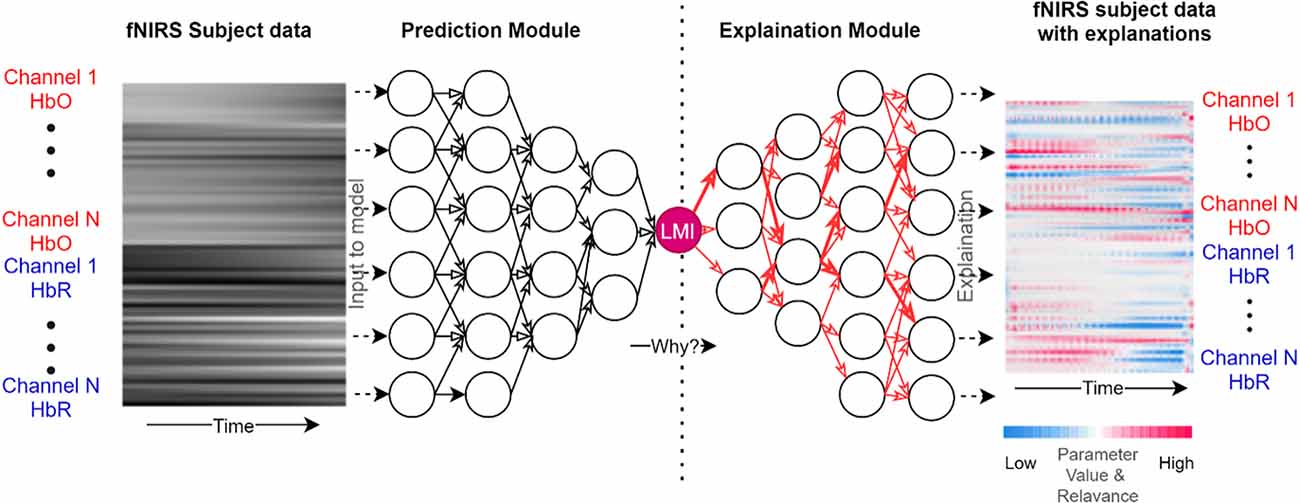
Figure 1. Overview of xAI-fNIRS system. The Deep Learning Model in the prediction module uses the data from each participant in the form of frames as input. The model provides a prediction based on this data, such as 97% LMI (Left Motor Imagery/Left Active). The Deep Learning Predictions are then explained in terms of input variables such as channel 1 HbO, channel 2 HbR, and so on in the Explanation module.
Three healthy subjects (Two females and one male) with a mean age of 25 years participated in the study. Ethical clearance was obtained for data acquisition from the Institutional Ethics committee of Sree Chitra Tirunal Institute for Medical Sciences and Technology ethics committee. For data acquisition, a continuous wave, multichannel fNIRS device (NIRsport from NIRx Medical Technologies LLC, Berlin, Germany, RRID: SCR_002491 and NIRStar (v.15.2) software (from NIRx Medical Technologies LLC, Berlin, Germany, RRID: SCR_014540) with two wavelengths (750 nm and 830 nm) and a sampling frequency of 7.8125 Hz, was employed. A total of eight sources and eight detectors were used in combination to form 20 channels. They were placed over bilateral motor cortices for signal acquisition, as shown in Figure 2. The Optode locations are based on the international 10–20 system (Homan et al., 1987). The distance between the source and the detector was 3 cm.
We used an open-access dataset from Technische Universität Berlin containing fNIRS motor imagery data. The dataset contained 28 right-handed and one healthy left-handed subjects with average age (years) 28.5 ± 3.7.
There were no neurological, neuropsychiatric, or other brain-related illnesses reported by any of the subjects. The experimental protocol was explained to all volunteers, and informed consent was obtained from all participants (Shin et al., 2017).
At the sampling rate of 10 Hz NIRS data was acquired using NIRScout (NIRx GmbH, Berlin, Germany). One physiological NIRS channel is created by each nearby source-detector pair. At three brain areas, 14 sources and 16 detectors were used to create 36 physiological channels. The frontal (nine channels around Fp1, Fp2, and Fpz), motor (12 channels around C3 and C4, respectively), and visual (three channels around Oz) portions of the brain were studied. (Figure 3).
The subjects were asked to be seated on a chair facing a computer monitor on which the experimental task was displayed. To generate a robust signal of the neural activity, subjects were requested to perform a motor execution. Subjects were instructed to relax before the paradigm began, to stabilize blood flow to the cortex. They were then instructed to relax during the rest period and open and close their left-hand or right-hand palm depending on the screen’s cue. Each subject had four sessions, and each session had 10 rest periods, each following an experimental event. The experiment involved 10 active motor execution tasks (five left and five right), each of 20-s duration separated by 20 s rest periods (Figure 4).
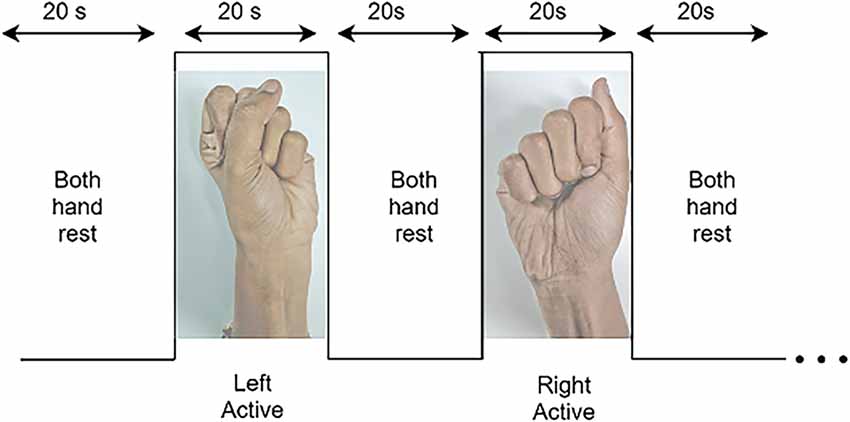
Figure 4. Dataset A: The paradigm for the experimental procedure includes rest and active motor tasks: right- and left-hand motor execution, starting from rest-state on both hands followed by left-hand motor execution task then both hand rest followed by right-hand motor execution.
Subjects were asked to engage in kinesthetic motor imagery (imagining opening and closing their hand while grasping a ball). A visual instruction appears on the screen in the form of a black arrow pointing left or right for 2 s. Throughout the activity, MI was performed for 10 s at a time, followed by a 15–17 s rest interval. In a single session, this was done 20 times (10 trials for each left- and right-hand MI in a single session: 30 trials for each one in the whole three sessions). MI tasks were done in a single session based on 10 following blocks, each consisting of one of two conditions: left-hand MI first, then right-hand MI, or vice versa (Shin et al., 2017; Figure 5).

Figure 5. Dataset B: Each session comprised a 1 min pre-experiment resting period, 20 repetitions of the given task, and a 1-min post-experiment resting period. The task started with 2 s of a visual introduction of the task, followed by 10 s of a task period and resting period.
AnalyzIR Toolbox (Santosa et al., 2018) was used to pre-process the fNIRS data. The raw signals were passed through a bandpass filter with a passband of 0.01–0.2 Hz. The filter helps in removing cardiac, respiratory, and other motion artifacts from the signal. Filtered signals were converted to oxygenated (ΔcHbO(t)) and deoxygenated (ΔcHbR(t)) hemoglobin concentration changes using modified Beer-Lamberts Law (Baker et al., 2014):
where ΔA(t,λj), j represents unitless absorbance (optical density), which is a measurement of the variation in light emitted at a specific wavelength. λj, αcHbO(λ1) and αcHbR(λ1) are the extinction coefficients of HbO and HbR (μ−1 mm−1) respectively, d is the unitless differential path length factor (DPF), and l is the distance between the emitter and detector. With the distance between the source and detector by default was maintained at 30 mm, NIRS signal is able to penetrate 15 mm into the gray matter of the brain (Gratton et al., 2006; Zhou et al., 2020; Yücel et al., 2021). Because fNIRS signals are sensitive to motion artifacts like respiration and heartbeat, channels having a coefficient of variation (CV, the standard deviation/mean) of each wavelength exceeding 7.5 were discarded (Minati et al., 2011; Balardin et al., 2017; Pfeifer et al., 2018).
The CNN architecture shown in Figure 6 can be divided into four parts (O’Shea and Nash, 2015):
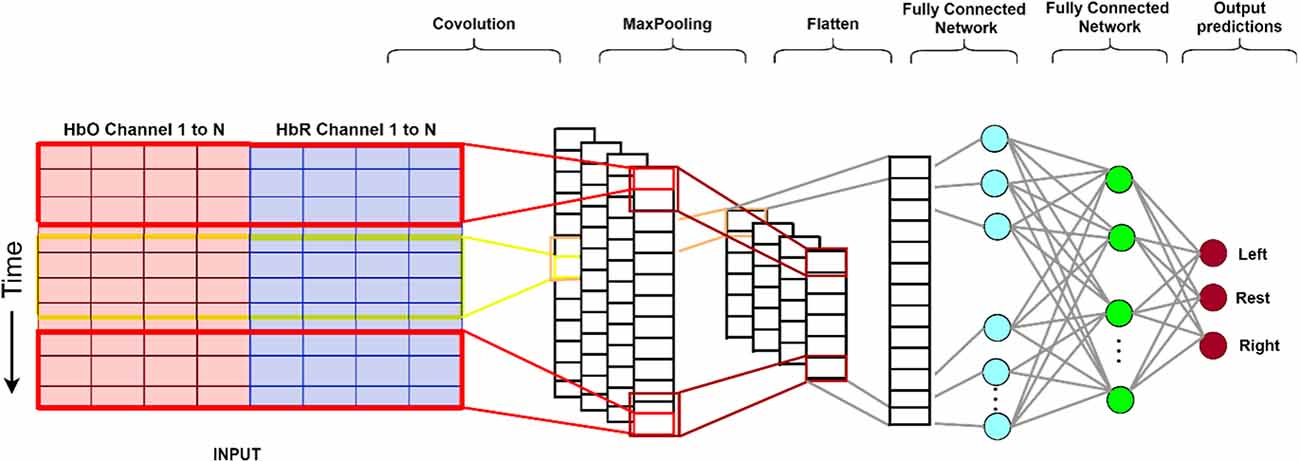
Figure 6. The structure of the CNN used in this study. From the input data (left), the convolutional (encoding) layers extract feature maps. Subsequently, these feature maps are resampled (max-pooling) to a coarser resolution before flattening to a 1-dimensional array. This is then passed on to the first fully connected network which applies weights to predict the correct label. Lastly, the final output layer computes and presents probabilities for each label (Gratton et al., 2006). CNN, convolutional neural network.
1. The input layer consists of an input matrix, which in our case, on the x-axis represents the fNIRS channels and the y-axis represents the fNIRS time-series data from each channel after windowing.
The convolutional layer has 32 1D kernels of size 3 (span in time, and spans across all channels), which calculates the neurons’ output for each channel.
The learnable kernels (filters used to extract features from the image matrix) use a small spatial dimensionality. When the data arrives at the convolutional layer, it convolves each filter across the input’s temporal dimension to produce a 2D feature map. The kernels have a corresponding activation map. Convolutional layers are optimized through three hyper-parameters, namely depth, stride, and zero-padding (Albawi et al., 2017). Depth of an image (assume a color image of dimension 50 × 50 and a depth of 3 which is RGB) or a grayscale video (dimension is height and breadth, and depth are the frames). Each convolutional layer has its own filter of a certain dimension which slides over the input matrix, this is controlled by stride. Stride is the number of pixels shifts over the input matrix. Zero padding is a commonly used modification where symmetrically zeros are added to the input matrix. This is done to preserve the dimension of the input volume in the output volume.
2. The pooling layer down samples along the temporal dimension, reducing the number of parameters within that feature map.
3. The fully connected layers contain neurons directly connected to adjacent layers without connecting to any of the neurons within the same layer. These three layers produce a class score from the activation maps, which are then used for classification.
• Long Short-Term memory, shown in Figure 7, is a type of Recurrent Neural Network (RNN) architecture that allows learning from long-term dependencies (Hochreiter and Schmidhuber, 1997; Sutskever et al., 2014; Lipton et al., 2015). The central concept of LSTM is a memory cell that maintains its state over time and is made up of explicit memory (cell state vector) and gating units that control information flow into and out of the memory.
• The LSTM’s memory is represented by the cell state vector, which alters the forgetting of old memory (forget gate) and the addition of new memory (input gate). The output from the previous time step, the current input, and, optionally, the cell status vector are used to govern the flow of information to and from memory.
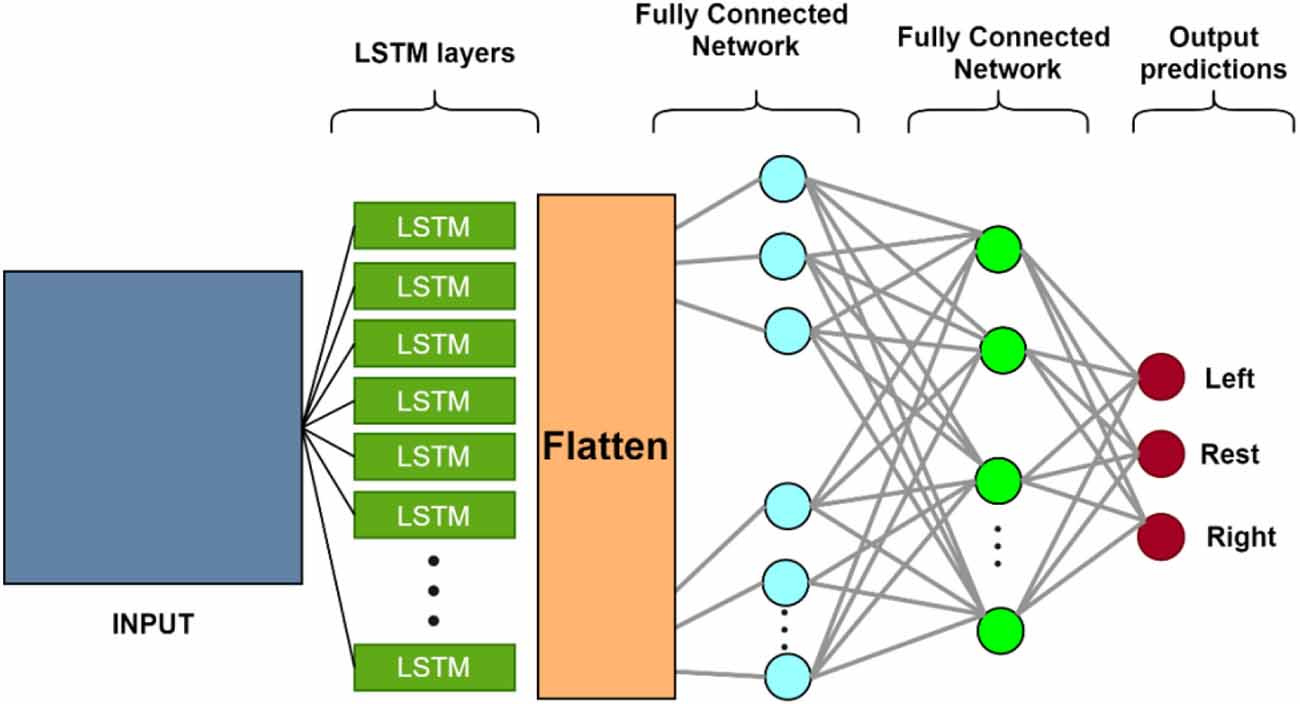
Figure 7. The structure of the LSTM neural network. Each LSTM neuron accepts sequential input data and has three regulators (Input-, output- and forget-gate). It processes the input sequence and determines features based on input data. The remaining structure consists of a dense neural network of three layers (Balardin et al., 2017). LSTM, long short-term memory.
This section explains the strategy used to evaluate the model’s performance using Accuracy, Precision, Recall, and F1 score (Goutte and Gaussier, 2005; Lin et al., 2018; Powers, 2020). First, a brief definition of key terms:
False-positive (FP): the rejection of true null hypothesis; False negative (FN): acceptance of the false null hypothesis; True positive (TP): outcome of the model that correctly predicts observation belonging to the positive class. True negative (TN): outcome of the model that correctly predicts observation belonging to the negative class. Accuracy, precision, recall, and F1 score are computed using these as follows:
A sliding window looks at the latest samples from the signal. fNIRS data is recorded as a time-series with M time samples and N channels where X1 is the latest block of size WS, and this block slides one row in time (from row1 to rowM-WS) till XM-WS. This gives an output of dimension [(M-WS) × WS × N] as shown in Figure 8.
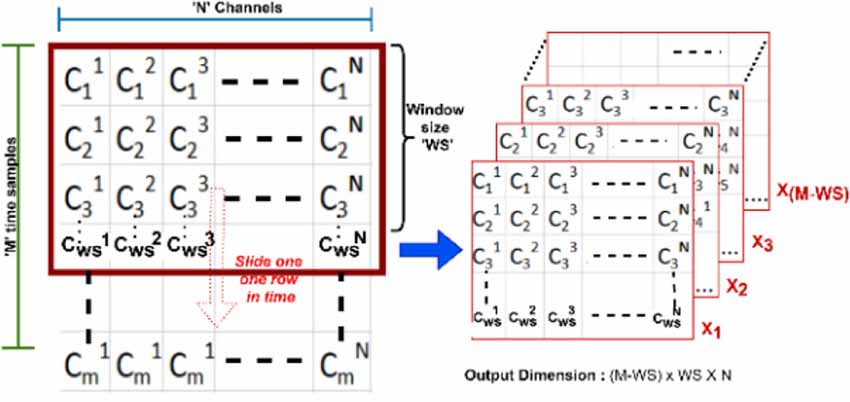
Figure 8. An example of a sliding window approach where M is time in frames, N is the number of channels, and WS is the window size.
For our study, we selected a window size of 50, which represents roughly 6 s of data for dataset A and 5 s for dataset B (open access). From the sliding window function’s output, each block’s dimension was computed as 1 × WS × N which is shown in Figure 9 where time is the WS and N is number of channels. Finally, this is labeled as “left,” “rest,” or “right” based on the experimental paradigm.
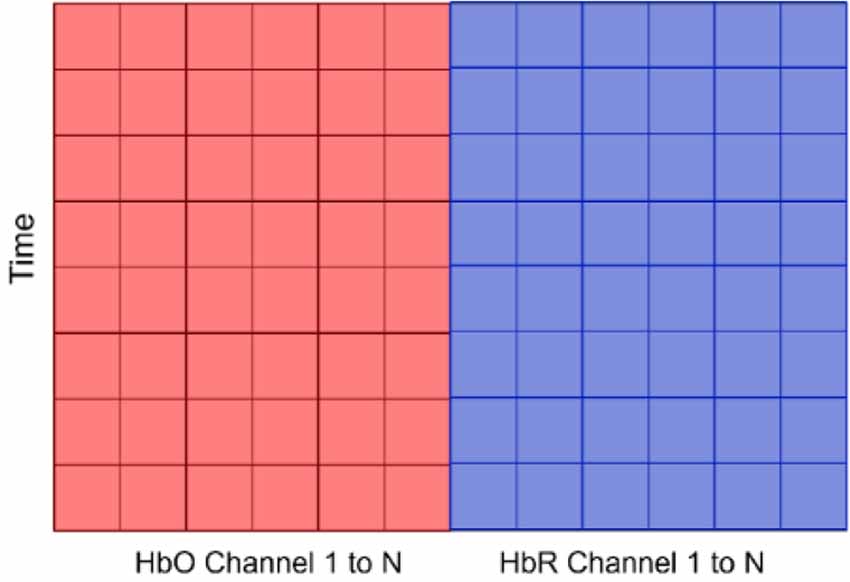
Figure 9. The input data consisting of concentration changes of HbO and HbR in all channels. N for Dataset A varies as we did not have consistent number of channels for all subjects, but for Dataset B, N is 76 (36 for HbO channels and 36 for HbR channels). Time refers to window size.
We followed two approaches to label each block:
Labeling approach 1: Consider a block of specific window size, WS. If, for example, the label “rest” appears in more than 50% of the latest block, then that block is labeled as “rest.” The same method is applied to label blocks as “right” or “left.” For Dataset A this approach has a latency of 4 s, and for Dataset B it has a latency of 5 s.
Labeling approach 2: Consider a block of window size (WS). If all the latest 1 s of labels for this block have a specific label, say left, then that block is labeled as left Likewise, the same is done in case the latest 1 s is labeled as rest or right. For both Dataset A and Dataset B, this approach has a latency of 1 s.
For better understanding of the CNN and LSTM models, the input and output sizes of each layer in our proposed CNN model are summarized in Table 1 and likewise for LSTM model are summarized in Table 2. Relu is an activation function that stands for rectified linear unit. If the input is positive, this piecewise linear function will output the input directly; otherwise, it will output a zero (Goodfellow et al., 2016; Arora et al., 2018; Agarap, 2019). Because it is faster to train the model and generally produces high accuracy, most neural networks utilize relu as their default activation function. Softmax is also an activation used in the output layer of the neural network that predicts a multinomial probability distribution for a multi-class classification problem (Goodfellow et al., 2016). Both Dataset A and B used “relu” as the activation function for all layers except the fully connected layer 3 which used a “softmax” as its activation function. Adam is used as an optimization algorithm instead of the classical stochastic gradient descent approach to iteratively update the weights based in the training data (Kingma and Ba, 2017). We used Adam as an optimizer as it has various benefits like easy implementation, computational efficiency, less memory requirements, etc.
It is computationally expensive to explore every potential feature combination while working with our datasets. DeepSHAP is a useful tool for estimating Shapley values in deep learning models. We are able to maintain the interpretive capability of Shapley values while maintaining the computational power and accurate outcomes of deep learning models. We can model Shapley values by additive feature attribution techniques for SHAP estimates. Through the explanatory model g, we describe the “coalition vector” z′ for SHAP as follows:
Here, we add the feature attribution for j, , multiplied by the coalition vector for j, , from feature j = 1 to the largest coalition size, M. () is the “coalition vector”. In the coalition vector, each feature is either “present” or “missing” in the combination of characteristics, denoted by a 1 or a 0.
We used DeepSHAP for our explanation module as it is optimized for explaining deep neural networks while having benefits which are:
(a) Global interpretability—The SHAP values can describe how each predictor or input variable contributes, either negatively or positively, to the target variable. This can be used to show each predictor’s positive and negative relationship with the target.
(b) Local interpretability—The SHAP value is assigned to each observation, which increases the transparency by showing how each case is predicted in terms of the contribution of each of the predictors. Traditional interpreters don’t explain individual cases but rather across the entire population. This enables us to pinpoint and contrast the impact of the predictors.
Using SHAP we can also find feature dependence, which is a form of global interpretation plot, where we choose a feature, and plot a point with the feature value on the x-axis and the appropriate Shapley value on the y-axis for each data instance.
Mathematically, we can describe the plot as:
With feature dependence we can also find SHAP interaction, which is interaction effects when pairwise features are attributions are considered. It is mathematically given as:
When i ≠ j:
Where S represents a subset of all features N except the i-th feature and M is the number of input features. This formula calculates the difference between the SHAP values of the i-th feature with and without the j-th feature and can be used to interpret the SHAP interaction value of the i-th feature with respect to the j-th feature. This enables us to compute SHAP interaction values using the algorithm for computing SHAP values (Lundberg and Lee, 2017).
The hemodynamic response obtained from subject 2 of Dataset A having 26 channels across all sessions of each task for rest, left, and right motor tasks with a window size of 50 are shown in Figure 10.
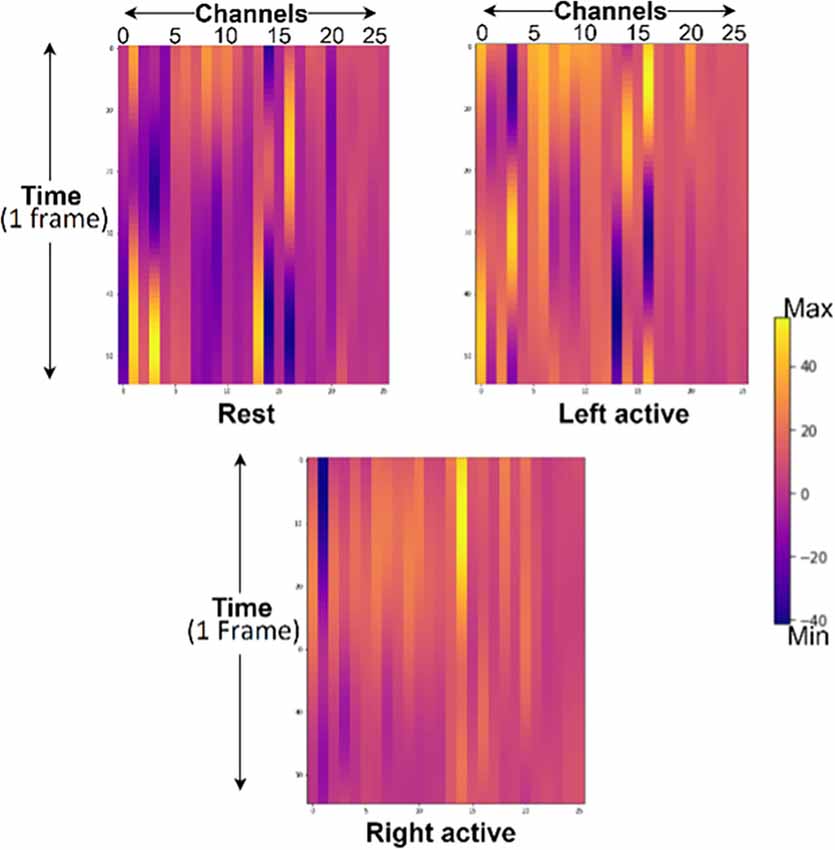
Figure 10. Hemodynamic response from rest, left- and right-motor task blocks of subject 2 from Dataset A where channels 1–13 represents HbO and 14–26 represents HbR. Yellow lines represent maximum, and purple represents minimum values respectively.
Changes in HbO- and HbR-concentration were measured as input to our proposed model.
LSTM and CNN were used to determine classification accuracies for each run of every subject. 10-fold cross-validation was performed on data with training- and validation- data split as 75% for training and 25% for testing.
The result of validation accuracy for each run of every subject for a window size WS of 50 samples (roughly 6 s of data) is shown in Figures 11 and 12 below:
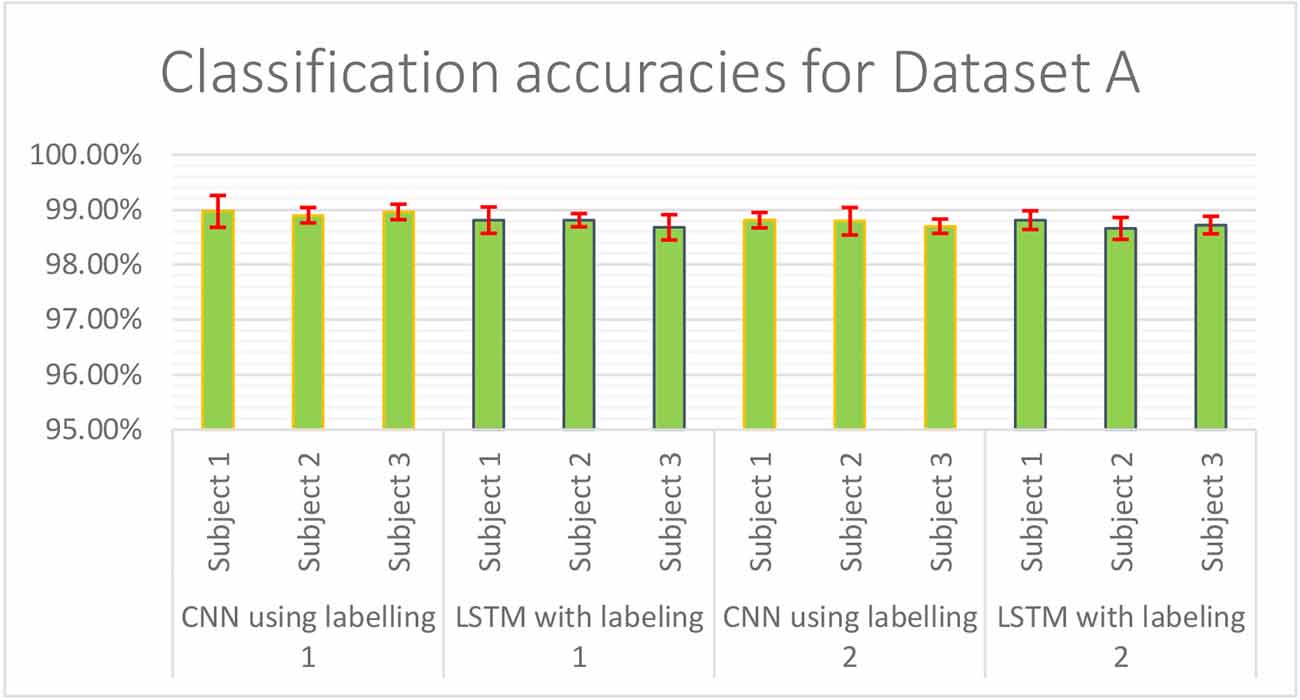
Figure 11. Classification accuracies of CNN and LSTM model using labeling approach -1 and -2 for Dataset A.
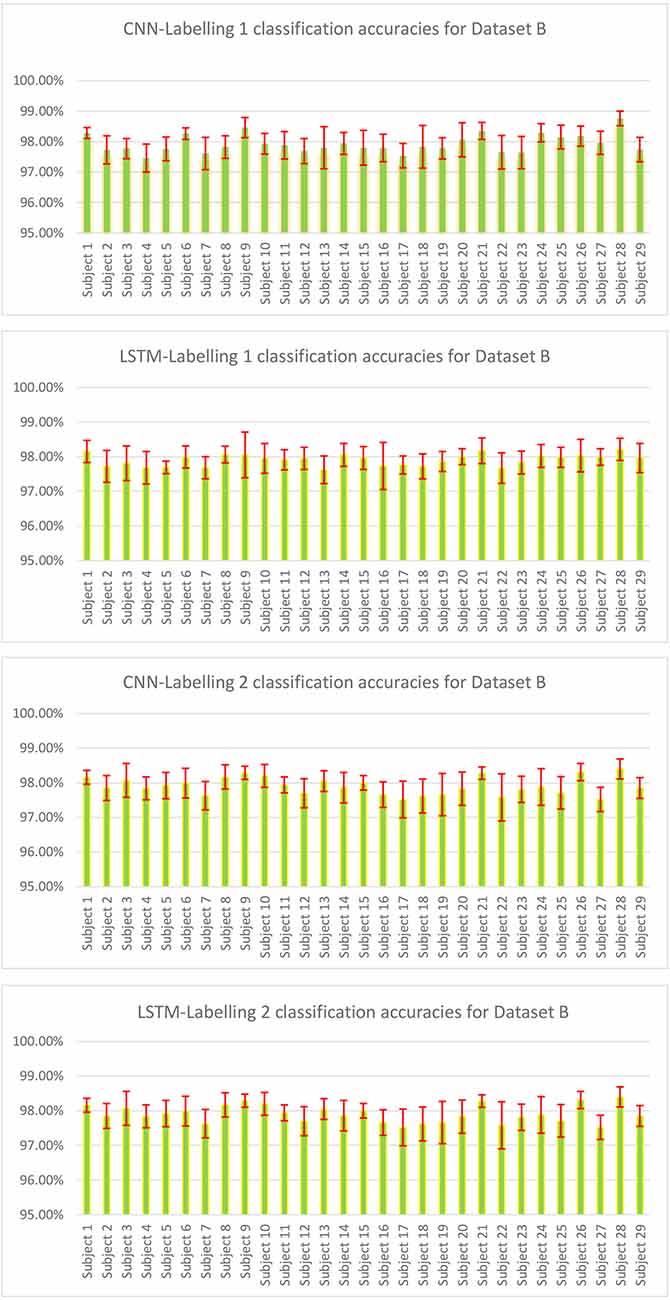
Figure 12. Classification accuracies of CNN and LSTM model for Dataset B where each subject had three sessions and all three were combined for 10-fold cross-validation, and 5-fold cross-validation was done for combined sessions.
The mean classification accuracy of CNN for Dataset A was 97.68% ± 0.05%, and that for Dataset B was 97.92% ± 0.28%. In LSTM, an average classification accuracy of 98.69% ± 0.04% was recorded for Dataset A and 97.88% ± 0.21% for Dataset B. To test the model for overfitting we randomized the labels. We then performed a permutation test with 10-fold cross-validation on Dataset A with randomized labels, which gave an accuracy of 39.54% ± 1.60% and 36.06% ± 1.88% for CNN and LSTM, respectively. Similarly, 10-fold cross-validated permutation test on Dataset B with randomized labels gave average accuracies of 56.55% ± 0.33% for CNN and 56.62% ± 0.39% for LSTM. Therefore our model is robust.
For subject independent classification we combined a few subjects (a combination of three, five and 10) for training and leaving out one for testing with 10-fold cross validation. The results are shown in Table 3. Dataset A gave an average classification accuracy of 50%. The same couldn’t be done for Dataset B as the number of channels from one subject to another varied.
Figure 13 shows that our model is not overfitting for both CNN and LSTM as training- and validation- accuracies and losses plots converge for each epoch.
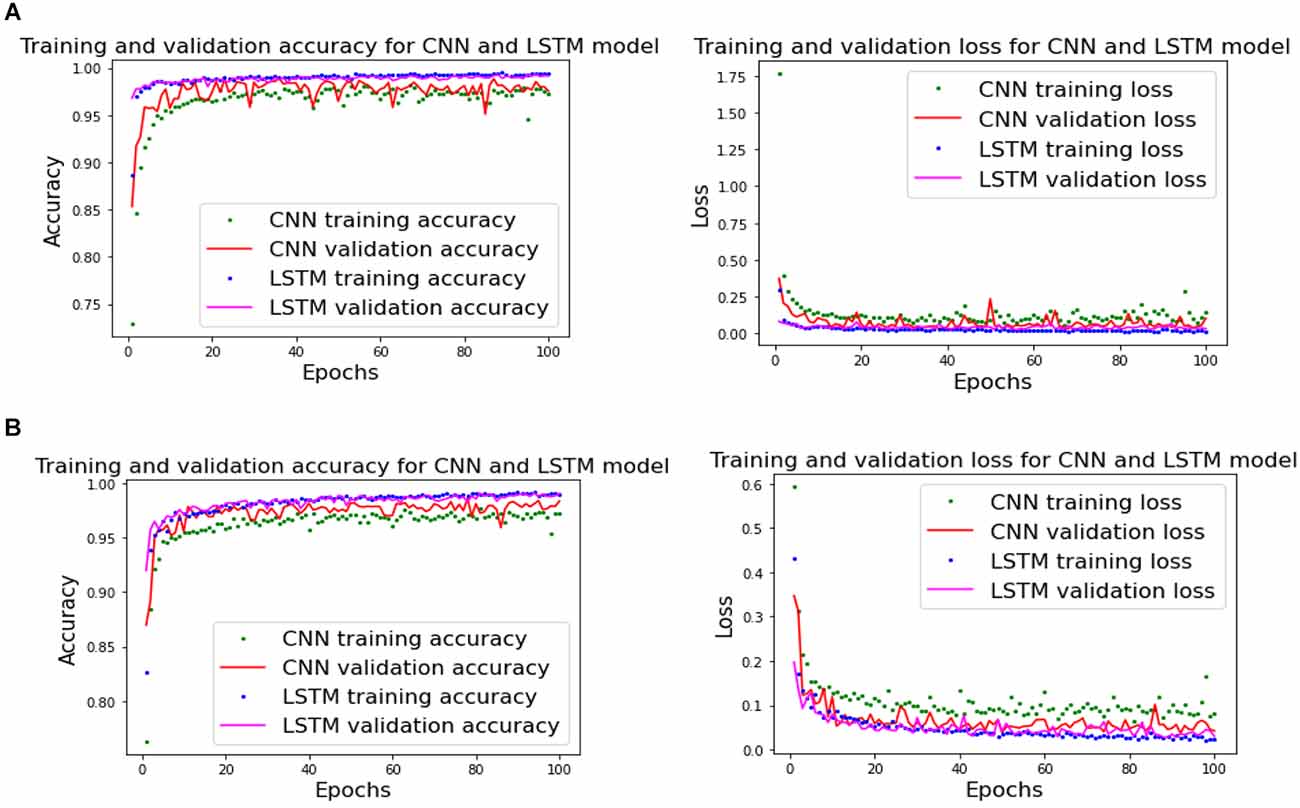
Figure 13. Training- and testing-accuracy and loss for CNN and LSTM. (A) Subject 1 of Dataset A and (B) Subject 12 of Dataset B.
Figure 14 shows the CNN model’s features for subject 3 of Dataset A, which is challenging to interpret. SHAP values were used to understand which features contributed the most. This is explained in the next section.

Figure 14. Spatiotemporal features from 32 1-d CNN filters where each filter has three coefficients (Shown for subject 3 with 26 channels for CNN classifier).
Our studies involved a Deep Learning model, and this necessitated the use of an explainer module. In our study, we used DeepExplainer, a module in DeepSHAP. The DeepExplainer examined the CNN model along with 2,000 random samples of data from the training set. SHAP values were extracted from 1,000 random samples from the test dataset. We obtained a SHAP value of the dimension 3 × 1,000 × 50 × 72 where 3 is the number of classes and 1,000 is the number of random samples of dimension 50 frames of data from 72 channels.
Figure 15, for Dataset A, the 10 most important channels for each of the three brain states (Left active, right active, and Rest) are shown. Figure 16, for Dataset B, the 10 most important channels for each of the three brain states (LMI, RMI, and Rest) are shown. With respect to deThe Channels are ranked by decreasing mean relevance calculated from local, back-propagated relevance ratings over subject 1 for Dataset A and subject 1 for dataset B.
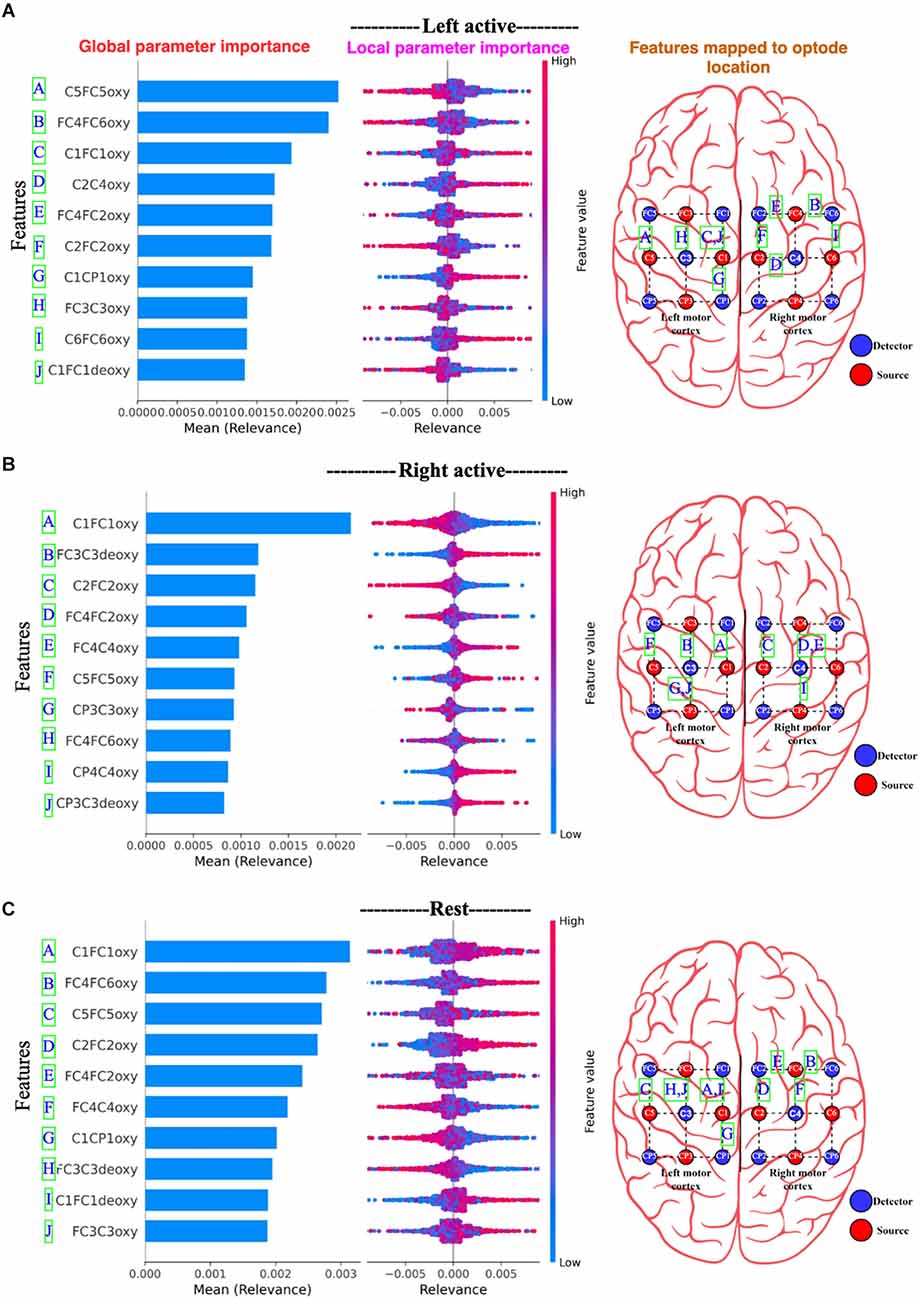
Figure 15. Panel (A) represents Left active motor task; (B) represents Right active motor task and likewise, (C) represents Rest. The global features’ importance and local explanations summary are displayed in the results of the explanation module for Dataset A. Note only 10 channels are plotted. On the right most part, the channels are mapped to the edges of the optode locations.
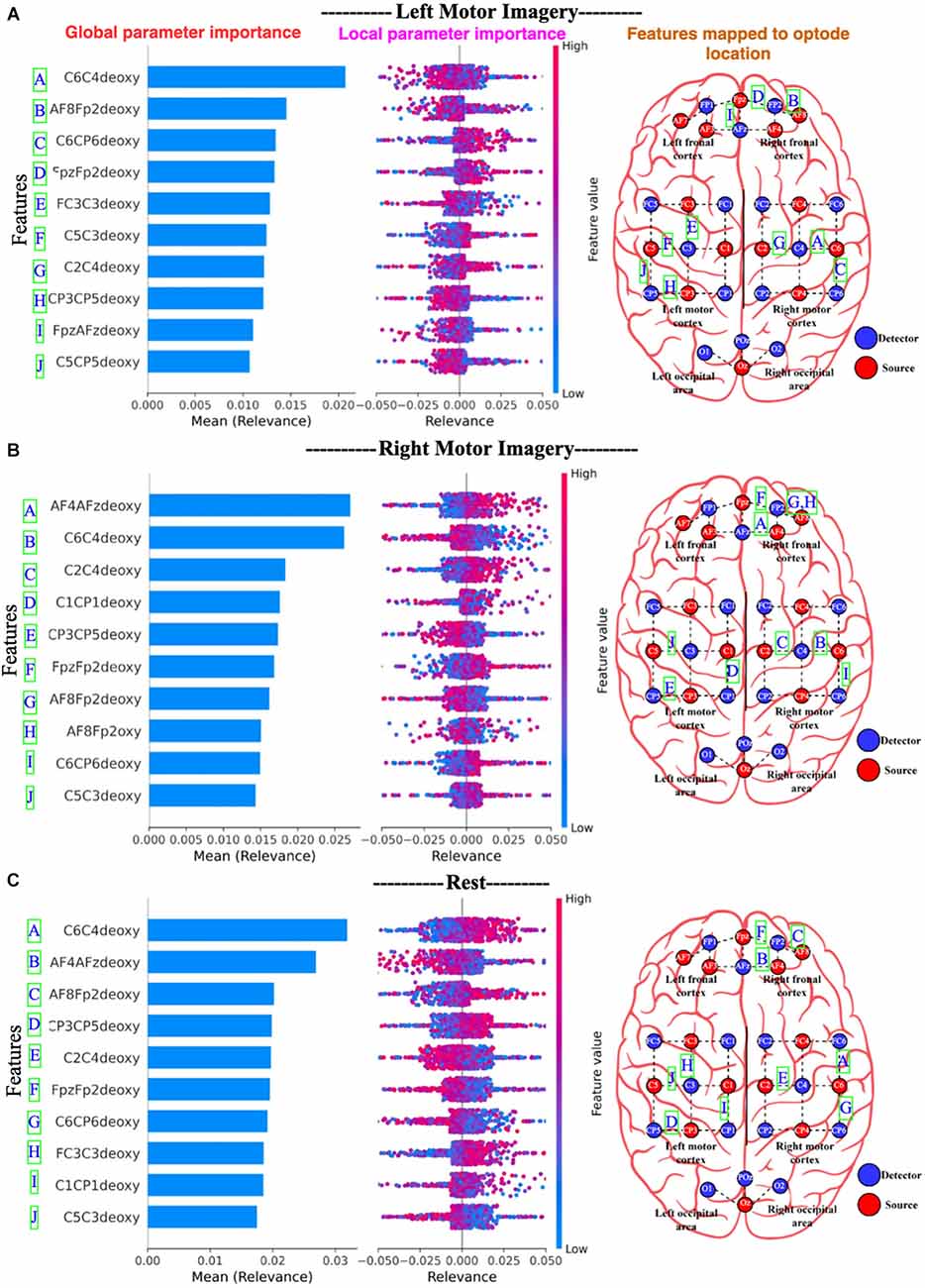
Figure 16. Panel (A) represents Left active motor imagery; (B) represents Right active motor imagery and likewise, (C) represents Rest. The global features’ importance and local explanations summary are displayed in the results of the explanation module for dataset B. Note only 10 channels are plotted. On the right most part, the channels are mapped to the edges of the optode locations.
In Figures 15 and 16, the parameters are displayed as a blue horizontal bar in ascending order of global parameter importance, as determined by mean relevance. All of the individual data points are colored by parameter value and sorted by mean importance in the local explanation summary. The number of data-points at the related level of relevance correlates with the height of the data-points for each feature, as determined by back-propagated relevance scores for each feature. The feature value linked with the local explanation is used to color-code this. The influence of a feature on the model’s categorization is indicated by the position of the dot on the x-axis. Multiple dots that land at the same × location pile up to demonstrate density. For example, Figure 15B Right active (Motor task) seems to associate with the high FC3C3deoxy and low C1FC1oxy from the left cortex. Likewise, Figure 16B Right motor imagery seems to be associated with high AF4AFzdeoxy and C2C4deoxy from the right frontal cortex and right motor cortex. The summary distribution allows us to get an idea of what to expect from the fNIRS signal classification model.
Another interesting finding is shown in Figure 17A Left motor imagery and (B) Right motor imagery where high values of channel C6C4deoxy contribute to other classes (rest or motor left imagery) than itself (right motor imagery), but it contributes to Rest state in (C) where it clearly shows the high values for channel C6C4deoxy contribute more towards the classification of Rest state.
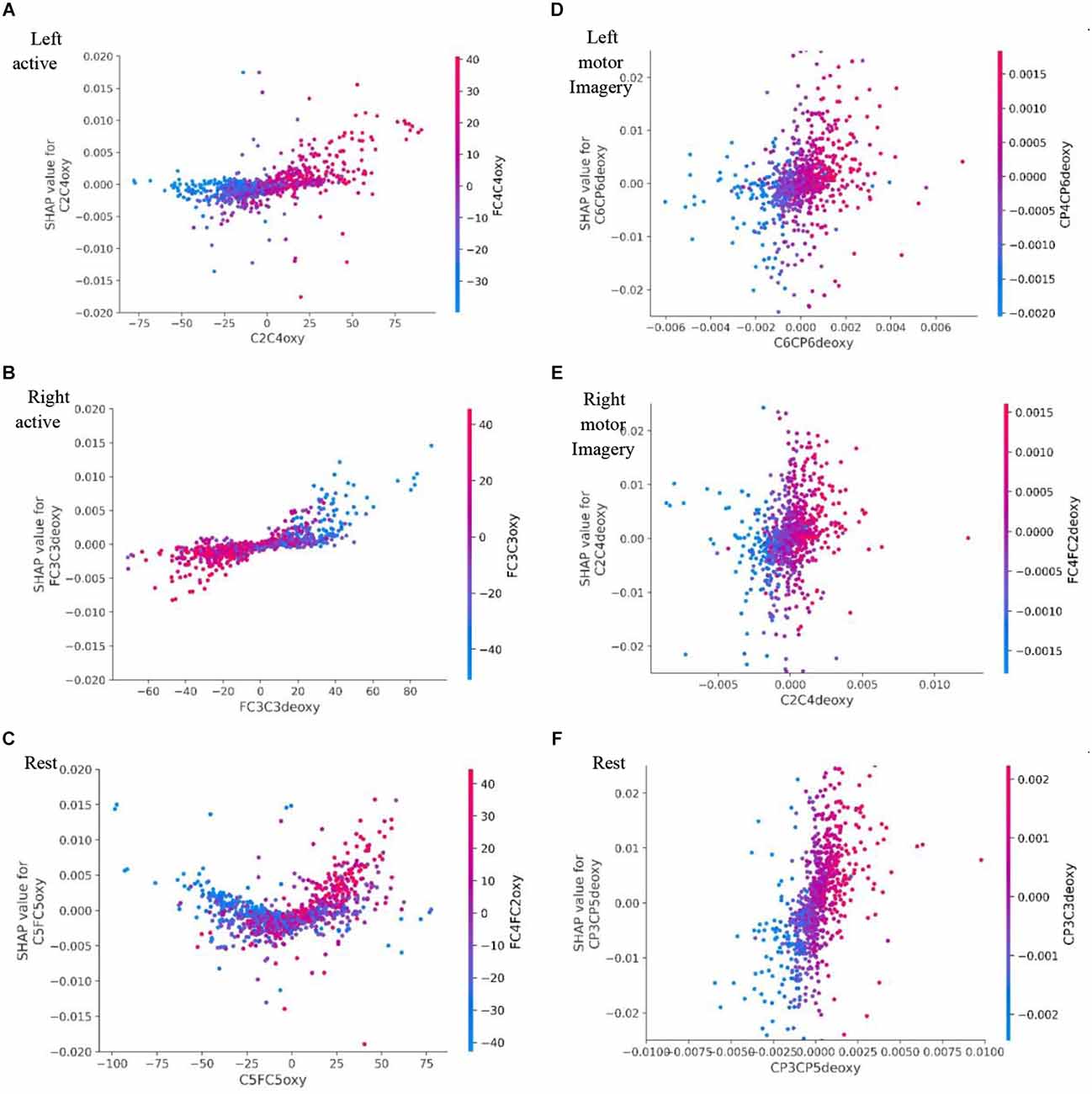
Figure 17. Dataset A’s SHAP dependance plot for: (A) represents Left active motor task; (B) represents Right active motor task and likewise (C) represents Rest. Dataset B’s SHAP dependance plot for: (D) represents Left motor imagery; (E) represents Right motor imagery and likewise (F) represents Rest. Here the SHAP dependence plot where the SHAP value of the feature has a positive effect on the classification is plotted against the value of the feature for all examples over the dataset and it is color coded with the feature it interacts with the most. SHAP, SHapley Additive exPlanations.
The dependence plot shows the marginal effect one or two features have on a Deep Learning model’s predicted outcome. Dependence plots display the relationship between a feature’s value (x-axis) and the prediction of each sample (each dot) in a dataset (y-axis). In comparison to conventional partial dependency charts, they offer deeper information. Figure 17 is a SHAP dependence plot where a feature that has a positive effect on classification is plotted against the value of that feature for all examples in the dataset.
Figure 17B right active, SHAP value of FC3C3deoxy is plotted against its actual value, clear interaction with FC3C3oxy, which increases the classification impact towards right active (Motor task). We can also observe that when the FC3C3deoxy value is low it has a negative impact and classifies anything other than right active, when the FC3C3deoxy value is high it has a positive impact towards classification of right active. Likewise, Figure 17D. Left motor imagery (LMI) channel CP4CP6deoxy shows interaction with channel FC2FC4deoxy, low values CP4CP6deoxy have negative impact towards classification of LMI and high values of CP4CP6deoxy contribute more towards LMI.
Deep Learning models like CNN and LSTM enable automated feature extraction and classification of fNIRS signals. The previous works on fNIRS used statistical features which were extracted for machine learning algorithms (Naseer and Hong, 2013; Naseer et al., 2014), e.g., mean, slope, skewness, etc. of HbO and HbR, which yielded a classification accuracy of 86.19% for SVM whereas CNN enhanced the classification accuracy to 93.08% (Trakoolwilaiwan et al., 2018).
The window-based approach (Naseer and Hong, 2013) restricts attention only to variation in data for contiguous windowed periods, whereas the proposed sliding window approach looks at multiple overlapping windows starting with each input sample.
As data scarcity is one limiting factor of Deep Learning techniques (Ghonchi et al., 2020; Lu et al., 2020; Nagabushanam et al., 2020) the sliding window also augments the data by increasing the data’s sample size, as explained in Section “Proposed sliding window approach”.
The Supplementary Material shows the number of channels available channels in Dataset A, which shows that despite fewer channels, the classification module can classify with an accuracy over 98% accuracy for both CNN and LSTM shown in Figure 12. We used Dataset B, an open-access dataset (Abibullaev and An, 2012) that consisted of motor imagery for 29 subjects to bolster our study. The classification module also gave a classification accuracy of over 98% for both CNN and LSTM for Dataset B, shown in Figure 12.
We trained the model with various window sizes from 1 s to 8 s and 5–6 s (50 frames), which led to the most optimal results. This shows that the longer the sliding window’s duration, the greater the amount of historical data in the window, which contributes to better classification accuracy.
For Dataset A, we could not perform intersubjective group classification as the number of channels did not remain constant for all three subjects. As for Dataset B, we performed intersubjective group classification shown in Supplementary Material; we observe that the accuracy is low due to a large outlier or lack of normalization of optode placement across all subjects.
The spatiotemporal features identified in Figure 14 show the fNIRS signal variation, from which the model has learned features for classification. Each of the filters describes temporal variation for three-time samples and spatial variation along the 26 channels (subject 3 of dataset A); however, it is not interpretable.
To introduce interpretability and trackability in neural networks for BCI purposes so far, few EGG studies have shown that it is possible to represent using direct pixel-to-channel mapping (Joshi et al., 2018), projection of sensor locations by interpolating image of the sensor on the scalp (Bashivan et al., 2015), and an fNIRS study channels with a frequency greater than mean were considered to be most contributing channels another fNIRS study used z-score and t-value methods for channel selection (Nazeer et al., 2020).
SHAP (SHapley Additive exPlanations) is a novel method that employs a game-theoretical approach to describe the output of a Deep Learning model. A recent study used SHAP to explain which channels contributed the most in classifying EEG data for the Active touch task (Alsuradi et al., 2020).
In the explanation module of the “xAI-fNIRS” system we aimed to explain which features contribute to the classification of a specific task in the CNN model for both Dataset A and Dataset Busing DeepSHAP which is a module in SHAP.
From Figures 16 and 17, we observe the high-relevance features (Channels) for Dataset A and Dataset B. We plotted 10 features (channels) that show the highest level of relevance for classification in descending order. An interesting finding is that the explanation module showed that Dataset A had all oxy values of channels that contribute the most to motor task brain states’ classification, whereas Dataset B had all deoxy values of channels for the classification of motor imagery brain states.
It is important to note that the xAI-fNIRS system presented in this study should not be conceived as the one-and-only multi-outcome model. Instead, it should be viewed as a general model for building precise and explainable models towards the development of better BCI systems.
In summary, we have presented the xAI-fNIRS system to classify brain activity states, which can be used for both task and imagery tasks in fNIRS. The xAI-fNIRS shows high classification performance while enabling the possibility of explaining the classification in terms of pinpointing decisive input data to provide BCI researchers to understand the underlying reasons for classification. We hope that our study will lead to developing a better BCI system that could not only perform with high accuracy prediction of brain states but also help in understanding the underlying spatiotemporal activation patterns.
The xAI-fNIRS system’s classification module showed high classification accuracy of greater than 98% a sliding window approach with Deep Learning models like CNN and LSTM. The sliding window approach keeps a history of signals and, at the same time, increases the dimension of the dataset. The classification module performed well, giving a high classification accuracy of over 98% for two datasets (Motor task and Motor imagery). Deep learning has gotten so good at classifying brain data, but it fails to reveal which features contribute the most to classification. To solve this issue, the explanation module aims to bring insight into reasons for classification by every channel given a color-coded relevance score; a positive relevance score contributes to the true class and vice versa. Hence the xAI-fNIRS system is a step towards building better BCI systems.
The raw data supporting the conclusion of this article can be made available on request. However, this is subject to the data sharing protocols of SCTIMST, Trivandrum, India.
The studies involving human participants were reviewed and approved by Institutional Ethics Committee (IEC) of the Sree Chitra Tirunal Institute for Medical Sciences and Technology, Trivandrum. The patients/participants provided their written informed consent to participate in this study. Informed consent was obtained from all individual participants included in the study. The clinical trial has been registered with identification no.SCT/IEC/801/AUGUST-2015.
CJS developed the xAI part of the Deep Learning network. CJS and SS were involved in the design of the Deep Learning network. All authors were involved in the formulation of the methodology, contributed to the writing of the article and approved the submitted version.
This study was funded by the Department of Biotechnology (DBT/IN/New Indigo/02/CK/2013) and the Indian Council of Medical Research (ICMR SRF File NO.5/3/8/50/ITR-F/2018-ITR). RS was supported by Comisión Nacional de Investigación Científica y Tecnológica de Chile (Conicyt) through Fondo Nacional de Desarrollo Científico y Tecnológico, Fondecyt (project n° 1171320 and 1171313) and CONICYT-PIA Anillo ACT172121.
We thank the Director of Sree Chitra Tirunal Institute for Medical Sciences and Technology for providing the resources to conduct this research.
The authors declare that the research was conducted in the absence of any commercial or financial relationships that could be construed as a potential conflict of interest.
All claims expressed in this article are solely those of the authors and do not necessarily represent those of their affiliated organizations, or those of the publisher, the editors and the reviewers. Any product that may be evaluated in this article, or claim that may be made by its manufacturer, is not guaranteed or endorsed by the publisher.
The Supplementary Material for this article can be found online at: https://www.frontiersin.org/articles/10.3389/fnhum.2022.1029784/full#supplementary-material.
Abibullaev, B., and An, J. (2012). Classification of frontal cortex haemodynamic responses during cognitive tasks using wavelet transforms and machine learning algorithms. Med. Eng. Phys. 34, 1394–1410. doi: 10.1016/j.medengphy.2012.01.002
Agarap, A. F. (2019). Deep learning using rectified linear units (ReLU). arXiv [Preprint]. doi: 10.48550/arXiv.1803.08375
Albawi, S., Mohammed, T. A., and Al-Zawi, S. (2017). “Understanding of a convolutional neural network,” in 2017 International Conference on Engineering and Technology (ICET), (Antalya, Turkey), 1–6.
Almulla, L., Al-Naib, I., and Althobaiti, M. (2020). Hemodynamic responses during standing and sitting activities: a study toward fNIRS-BCI. Biomed. Phys. Eng. Express. 6:055005. doi: 10.1088/2057-1976/aba102
Alsuradi, H., Park, W., and Eid, M. (2020). “Explainable classification of EEG data for an active touch task using shapley values,” in HCI International 2020 - Late Breaking Papers: Multimodality and Intelligence 6, eds C. Stephanidis, M. Kurosu, H. Degen and L. Reinerman-Jones (Cham: Springer International Publishing), 406–416.
Alvarez-Melis, D., and Jaakkola, T. S. (2018). On the robustness of interpretability methods. arXiv [Preprint]. doi: 10.48550/arXiv.1806.08049
Arenth, P. M., Ricker, J. H., and Schultheis, M. T. (2007). Applications of functional near-infrared spectroscopy (fNIRS) to neurorehabilitation of cognitive disabilities. Clin. Neuropsychol. 21, 38–57. doi: 10.1080/13854040600878785
Arora, R., Basu, A., Mianjy, P., and Mukherjee, A. (2018). Understanding deep neural networks with rectified linear units. arXiv [Preprint]. doi: 10.48550/arXiv.1611.01491
Arun, K. M., Smitha, K. A., Rajesh, P. G., and Kesavadas, C. (2018). Functional near-infrared spectroscopy is in moderate accordance with functional MRI in determining lateralisation of frontal language areas. Neuroradiol. J. 31, 133–141. doi: 10.1177/1971400917739083
Baker, W. B., Parthasarathy, A. B., Busch, D. R., Mesquita, R. C., Greenberg, J. H., and Yodh, A. G. (2014). Modified Beer-Lambert law for blood flow. Biomed. Opt. Express 5, 4053–4075. doi: 10.1364/BOE.5.004053
Balardin, J. B., Zimeo Morais, G. A., Furucho, R. A., Trambaiolli, L., Vanzella, P., Biazoli, C., et al. (2017). Imaging brain function with functional near-infrared spectroscopy in unconstrained environments. Front. Hum. Neurosci. 11:258. doi: 10.3389/fnhum.2017.00258
Bashivan, P., Rish, I., Yeasin, M., and Codella, N. (2015). Learning representations from EEG with deep recurrent-convolutional neural networks. arXiv [Preprint]. doi: 10.48550/arXiv.1511.06448
Bauernfeind, G., Scherer, R., Pfurtscheller, G., and Neuper, C. (2011). Single-trial classification of antagonistic oxyhemoglobin responses during mental arithmetic. Med. Biol. Eng. Comput. 49, 979–984. doi: 10.1007/s11517-011-0792-5
Benitez-Andonegui, A., Burden, R., Benning, R., Möckel, R., Lührs, M., and Sorger, B. (2020). An augmented-reality fNIRS-based brain-computer interface: a proof-of-concept study. Front. Neurosci. 14:346. doi: 10.3389/fnins.2020.00346
Buccino, A. P., Keles, H. O., and Omurtag, A. (2016). Hybrid EEG-fNIRS asynchronous brain-computer interface for multiple motor tasks. PLoS One 11:e0146610. doi: 10.1371/journal.pone.0146610
Chiarelli, A. M., Croce, P., Merla, A., and Zappasodi, F. (2018). Deep learning for hybrid EEG-fNIRS brain-computer interface: application to motor imagery classification. J. Neural Eng. 15:036028. doi: 10.1088/1741-2552/aaaf82
Coyle, S. M., Ward, T. E., and Markham, C. M. (2007). Brain–computer interface using a simplified functional near-infrared spectroscopy system. J. Neural Eng. 4, 219–226. doi: 10.1088/1741-2560/4/3/007
Faress, A., and Chau, T. (2013). Towards a multimodal brain-computer interface: combining fNIRS and fTCD measurements to enable higher classification accuracy. Neuroimage 77, 186–194. doi: 10.1016/j.neuroimage.2013.03.028
Gaur, P., Gupta, H., Chowdhury, A., McCreadie, K., Pachori, R. B., and Wang, H. (2021a). A sliding window common spatial pattern for enhancing motor imagery classification in EEG-BCI. IEEE Trans. Instrum. Meas. 70, 1–9. doi: 10.1109/TIM.2021.3051996
Gaur, P., McCreadie, K., Pachori, R. B., Wang, H., and Prasad, G. (2021b). An automatic subject specific channel selection method for enhancing motor imagery classification in EEG-BCI using correlation. Biomed. Signal Process. Control 68:102574. doi: 10.1016/j.bspc.2021.102574
Ghaffar, M. S. B. A., Khan, U. S., Iqbal, J., Rashid, N., Hamza, A., Qureshi, W. S., et al. (2021). Improving classification performance of four class FNIRS-BCI using Mel Frequency Cepstral Coefficients (MFCC). Infrared Phys. Technol. 112:103589. doi: 10.1016/j.infrared.2020.103589
Ghonchi, H., Fateh, M., Abolghasemi, V., Ferdowsi, S., and Rezvani, M. (2020). “Spatio-temporal deep learning for EEG-fNIRS brain computer interface,” in 2020 42nd Annual International Conference of the IEEE Engineering in Medicine Biology Society (EMBC), (Montreal, QC, Canada), 124–127.
Goutte, C., and Gaussier, E. (2005). “A Probabilistic interpretation of precision, recall and F-score, with implication for evaluation,” in Advances in Information Retrieval, eds D. E. Losada and J. M. Fernández-Luna (Berlin, Heidelberg: Springer), 345–359.
Gratton, G., Brumback, C. R., Gordon, B. A., Pearson, M. A., Low, K. A., and Fabiani, M. (2006). Effects of measurement method, wavelength and source-detector distance on the fast optical signal. Neuroimage 32, 1576–1590. doi: 10.1016/j.neuroimage.2006.05.030
Gunning, D., and Aha, D. (2019). DARPA’s explainable artificial intelligence (XAI) program. AI Mag. 40, 44–58. doi: 10.1609/aimag.v40i2.2850
Hochreiter, S., and Schmidhuber, J. (1997). Long short-term memory. Neural Comput. 9, 1735–1780. doi: 10.1162/neco.1997.9.8.1735
Holper, L., and Wolf, M. (2011). Single-trial classification of motor imagery differing in task complexity: a functional near-infrared spectroscopy study. J. Neuroeng. Rehabil. 8:34. doi: 10.1186/1743-0003-8-34
Homan, R. W., Herman, J., and Purdy, P. (1987). Cerebral location of international 10-20 system electrode placement. Electroencephalogr. Clin. Neurophysiol. 66, 376–382. doi: 10.1016/0013-4694(87)90206-9
Hong, K. S., Naseer, N., and Kim, Y. H. (2015). Classification of prefrontal and motor cortex signals for three-class fNIRS-BCI. Neurosci. Lett. 587, 87–92. doi: 10.1016/j.neulet.2014.12.029
Hong, K. S., and Santosa, H. (2016). Decoding four different sound-categories in the auditory cortex using functional near-infrared spectroscopy. Hear. Res. 333, 157–166. doi: 10.1016/j.heares.2016.01.009
Irani, F., Platek, S. M., Bunce, S., Ruocco, A. C., and Chute, D. (2007). Functional near infrared spectroscopy (fNIRS): an emerging neuroimaging technology with important applications for the study of brain disorders. Clin. Neuropsychol. 21, 9–37. doi: 10.1080/13854040600910018
Janani, A., Sasikala, M., Chhabra, H., Shajil, N., and Venkatasubramanian, G. (2020). Investigation of deep convolutional neural network for classification of motor imagery fNIRS signals for BCI applications. Biomed. Signal Process. Control 62:102133. doi: 10.1016/j.bspc.2020.102133
Joshi, R., Goel, P., Sur, M., and Murthy, H. A. (2018). “Single trial P300 classification using convolutional LSTM and deep learning ensembles method,” in Intelligent Human Computer Interaction, ed U. Tiwary (Cham: Springer), 3–15.
Khoa, T. Q. D., and Nakagawa, M. (2008). Functional near infrared spectroscope for cognition brain tasks by wavelets analysis and neural networks. Int. J. Psychol. Behav. Sci. 2, 89–94. doi: 10.5281/zenodo.1082245
Kingma, D. P., and Ba, J. (2017). Adam: a method for stochastic optimization. arXiv [Preprint]. doi: 10.48550/arXiv.1412.6980
Li, C., Su, M., Xu, J., Jin, H., and Sun, L. (2020). A between-subject fNIRS-BCI study on detecting self-regulated intention during walking. IEEE Trans. Neural Syst. Rehabil. Eng. 28, 531–540. doi: 10.1109/TNSRE.2020.2965628
Lin, W., Tong, T., Gao, Q., Guo, D., Du, X., Yang, Y., et al. (2018). Convolutional neural networks-based MRI image analysis for the Alzheimer’s disease prediction from mild cognitive impairment. Front. Neurosci. 12:777. doi: 10.3389/fnins.2018.00777
Lipton, Z. C., Berkowitz, J., and Elkan, C. (2015). A critical review of recurrent neural networks for sequence learning. arXiv [Preprint]. doi: 10.48550/arXiv.1506.00019
Lu, J., Yan, H., Chang, C., and Wang, N. (2020). “Comparison of machine learning and deep learning approaches for decoding brain computer interface: an fNIRS study,” in Intelligent Information Processing X., eds Z. Shi, S. Vadera and E. Chang (Cham: Springer International Publishing), 192–201.
Lundberg, S. M., and Lee, S. I. (2017). A unified approach to interpreting model predictions. Adv. Neural Inform. Process. Syst. 30, 4765–4774. doi: 10.48550/arXiv.1705.07874
Luo, S. (2020). RTCOG: online ECoG-based brain-computer interface system for the decoding, synthesis and classification of speech neural signals. Available online at: http://jhir.library.jhu.edu/handle/1774.2/62726.
Minati, L., Visani, E., Dowell, N. G., Medford, N., and Critchley, H. D. (2011). Variability comparison of simultaneous brain near-infrared spectroscopy (NIRS) and functional MRI (fMRI) during visual stimulation. J. Med. Eng. Technol. 35, 370–376. doi: 10.3109/03091902.2011.595533
Nagabushanam, P., Thomas George, S., and Radha, S. (2020). EEG signal classification using LSTM and improved neural network algorithms. Soft Comput. 24, 9981–10003. doi: 10.1007/s00500-019-04515-0
Naseer, N., and Hong, K. S. (2013). Classification of functional near-infrared spectroscopy signals corresponding to the right- and left-wrist motor imagery for development of a brain-computer interface. Neurosci. Lett. 553, 84–89. doi: 10.1016/j.neulet.2013.08.021
Naseer, N., and Hong, K. S. (2015). fNIRS-based brain-computer interfaces: a review. Front. Hum. Neurosci. 9:3. doi: 10.3389/fnhum.2015.00003
Naseer, N., Hong, M. J., and Hong, K. S. (2014). Online binary decision decoding using functional near-infrared spectroscopy for the development of brain-computer interface. Exp. Brain Res. 232, 555–564. doi: 10.1007/s00221-013-3764-1
Naseer, N., Noori, F. M., Qureshi, N. K., and Hong, K. S. (2016). Determining optimal feature-combination for LDA classification of functional near-infrared spectroscopy signals in brain-computer interface application. Front. Hum. Neurosci. 10:237. doi: 10.3389/fnhum.2016.00237
Nazeer, H., Naseer, N., Khan, R. A., Noori, F. M., Qureshi, N. K., Khan, U. S., et al. (2020). Enhancing classification accuracy of fNIRS-BCI using features acquired from vector-based phase analysis. J. Neural Eng. 17:056025. doi: 10.1088/1741-2552/abb417
Nguyen, A., Kim, J., Oh, H., Kim, H., Lin, W., and Lee, S. (2019). Deep visual saliency on stereoscopic images. IEEE Trans. Image Process. 28, 1939–1953. doi: 10.1109/TIP.2018.2879408
O’Shea, K., and Nash, R. (2015). An introduction to convolutional neural networks. arXiv [Preprint]. doi: 10.48550/arXiv.1511.08458
Olmos, R., Tabik, S., Lamas, A., Pérez-Hernández, F., and Herrera, F. (2019). A binocular image fusion approach for minimizing false positives in handgun detection with deep learning. Info. Fusion 49, 271–280. doi: 10.1016/j.inffus.2018.11.015
Ovchinnikova, A. O., Vasilyev, A. N., Zubarev, I. P., Kozyrskiy, B. L., and Shishkin, S. L. (2021). MEG-based detection of voluntary eye fixations used to control a computer. Front. Neurosci. 15:619591. doi: 10.3389/fnins.2021.619591
Pfeifer, M. D., Scholkmann, F., and Labruyère, R. (2018). Signal processing in functional near-infrared spectroscopy (fNIRS): methodological differences lead to different statistical results. Front. Hum. Neurosci. 11:641. doi: 10.3389/fnhum.2017.00641
Powers, D. M. (2020). Evaluation: from precision, recall and F-measure to ROC, informedness, markedness and correlation. arXiv [Preprint]. doi: 10.48550/arXiv.2010.16061
Rathee, D., Raza, H., Roy, S., and Prasad, G. (2021). A magnetoencephalography dataset for motor and cognitive imagery-based brain-computer interface. Sci. Data 8:120. doi: 10.1038/s41597-021-00899-7
Ribeiro, M. T., Singh, S., and Guestrin, C. (2016). “Why should i trust you?,” in Proceedings of the 22nd ACM SIGKDD International Conference on Knowledge Discovery and Data Mining (New York, NY, USA), 1135–1144. doi: 10.1145/2939672.2939778
Rieke, J. D., Matarasso, A. K., Yusufali, M. M., Ravindran, A., Alcantara, J., White, K. D., et al. (2020). Development of a combined, sequential real-time fMRI and fNIRS neurofeedback system to enhance motor learning after stroke. J. Neurosci. Methods 341:108719. doi: 10.1016/j.jneumeth.2020.108719
Roy, S., Youssofzadeh, V., McCreadie, K., and Prasad, G. (2020). Mapping BCI task imagery brain responses using MEG beta power desynchrony effects. Available online at: https://pure.ulster.ac.uk/en/publications/mapping-bci-task-imagery-brain-responses-using-meg-beta-power-des.
Santosa, H., Zhai, X., Fishburn, F., and Huppert, T. (2018). The NIRS brain analyzIR toolbox. Algorithms 11:73. doi: 10.3390/a11050073
Shibu, C. J., Sreedharan, S., KM, A., and Kesavadas, C. (2020). “Comparison of classification performance of handpicked, handcrafted and automated-features for fNIRS-BCI system,” in 2020 5th International Conference on Intelligent Informatics and Biomedical Sciences (ICIIBMS), (Okinawa, Japan), 152–157. doi: 10.1109/iciibms50712.2020.9336392
Shin, J., von Lühmann, A., Blankertz, B., Kim, D. W., Jeong, J., Hwang, H. J., et al. (2017). Open access dataset for EEG+NIRS single-trial classification. IEEE Trans. Neural Syst. Rehabil. Eng. 25, 1735–1745. doi: 10.1109/TNSRE.2016.2628057
Shrikumar, A., Greenside, P., Shcherbina, A., and Kundaje, A. (2017). Not just a black box: learning important features through propagating activation differences. arXiv [Preprint]. doi: 10.48550/arXiv.1605.01713
Simon, J., Fishbein, P., Zhu, L., Roberts, M., and Martin, I. (2020). “Functional magnetic resonance imaging-based brain computer interfaces,” in Neural Interface Engineering: Linking the Physical World and the Nervous System, ed L. Guo (Cham: Springer International Publishing), 17–47.
Sitaram, R., Ros, T., Stoeckel, L., Haller, S., Scharnowski, F., Lewis-Peacock, J., et al. (2017). Closed-loop brain training: the science of neurofeedback. Nat. Rev. Neurosci. 18, 86–100. doi: 10.1038/nrn.2016.164
Sitaram, R., Zhang, H., Guan, C., Thulasidas, M., Hoshi, Y., Ishikawa, A., et al. (2007). Temporal classification of multichannel near-infrared spectroscopy signals of motor imagery for developing a brain-computer interface. Neuroimage 34, 1416–1427. doi: 10.1016/j.neuroimage.2006.11.005
Sorger, B., and Goebel, R. (2020). Real-time fMRI for brain-computer interfacing. Handb. Clin. Neurol. 168, 289–302. doi: 10.1016/B978-0-444-63934-9.00021-4
Stojic, F., and Chau, T. (2020). Nonspecific visuospatial imagery as a novel mental task for online EEG-based BCI control. Int. J. Neur. Syst. 30:2050026. doi: 10.1142/S0129065720500264
Sutskever, I., Vinyals, O., and Le, Q. V. (2014). Sequence to sequence learning with neural networks. arXiv [Preprint]. doi: 10.48550/arXiv.1409.3215
Tai, K., and Chau, T. (2009). Single-trial classification of NIRS signals during emotional induction tasks: towards a corporeal machine interface. J. Neuroeng. Rehabil. 6:39. doi: 10.1186/1743-0003-6-39
Tanveer, M. A., Khan, M. J., Qureshi, M. J., Naseer, N., and Hong, K. (2019). Enhanced drowsiness detection using deep learning: an fNIRS study. IEEE Access 7, 137920–137929. doi: 10.1109/ACCESS.2019.2942838
Trakoolwilaiwan, T., Behboodi, B., Lee, J., Kim, K., and Choi, J. W. (2018). Convolutional neural network for high-accuracy functional near-infrared spectroscopy in a brain-computer interface: three-class classification of rest, right- and left-hand motor execution. Neurophotonics 5:011008. doi: 10.1117/1.NPh.5.1.011008
Wang, L., and Liu, R. (2020). Human activity recognition based on wearable sensor using hierarchical deep LSTM networks. Circuits Syst. Signal Process. 39, 837–856. doi: 10.1007/s00034-019-01116-y
Wolpaw, J. R., Birbaumer, N., McFarland, D. J., Pfurtscheller, G., and Vaughan, T. M. (2002). Brain-computer interfaces for communication and control. Clin. Neurophysiol. 113, 767–791. doi: 10.1016/s1388-2457(02)00057-3
Yücel, M. A., Lühmann, A. v., Scholkmann, F., Gervain, J., Dan, I., Ayaz, H., et al. (2021). Best practices for fNIRS publications. Neurophotonics 8:012101. doi: 10.1117/1.NPh.8.1.012101
Ying, W., Zhang, L., and Deng, H. (2020). Sichuan dialect speech recognition with deep LSTM network. Front. Comput. Sci. 14, 378–387. doi: 10.1007/s11704-018-8030-z
Zhang, X., Xiong, Q., Dai, Y., Xu, X., and Song, G. (2020). An ECoG-based binary classification of BCI using optimized extreme learning machine. Complexity 2020:e2913019. doi: 10.1155/2020/2913019
Keywords: brain state classification, functional near-infrared spectroscopy, brain-computer interface, deep learning, convolutional neural networks, long short-term memory, explainable AI
Citation: Shibu CJ, Sreedharan S, Arun KM, Kesavadas C and Sitaram R (2023) Explainable artificial intelligence model to predict brain states from fNIRS signals. Front. Hum. Neurosci. 16:1029784. doi: 10.3389/fnhum.2022.1029784
Received: 27 August 2022; Accepted: 21 November 2022;
Published: 19 January 2023
Edited by:
Shenghong He, University of Oxford, United KingdomReviewed by:
Jinung An, Daegu Gyeongbuk Institute of Science and Technology (DGIST), South KoreaCopyright © 2023 Shibu, Sreedharan, Arun, Kesavadas and Sitaram. This is an open-access article distributed under the terms of the Creative Commons Attribution License (CC BY). The use, distribution or reproduction in other forums is permitted, provided the original author(s) and the copyright owner(s) are credited and that the original publication in this journal is cited, in accordance with accepted academic practice. No use, distribution or reproduction is permitted which does not comply with these terms.
*Correspondence: Sujesh Sreedharan, c3VqZXNoc0BzY3RpbXN0LmFjLmlu; Ranganatha Sitaram, cmFuZ2FuYXRoYS5zaXRhcmFtQHN0anVkZS5vcmc=
Disclaimer: All claims expressed in this article are solely those of the authors and do not necessarily represent those of their affiliated organizations, or those of the publisher, the editors and the reviewers. Any product that may be evaluated in this article or claim that may be made by its manufacturer is not guaranteed or endorsed by the publisher.
Research integrity at Frontiers

Learn more about the work of our research integrity team to safeguard the quality of each article we publish.